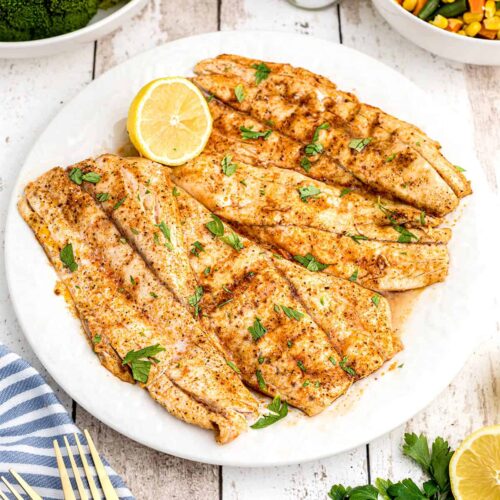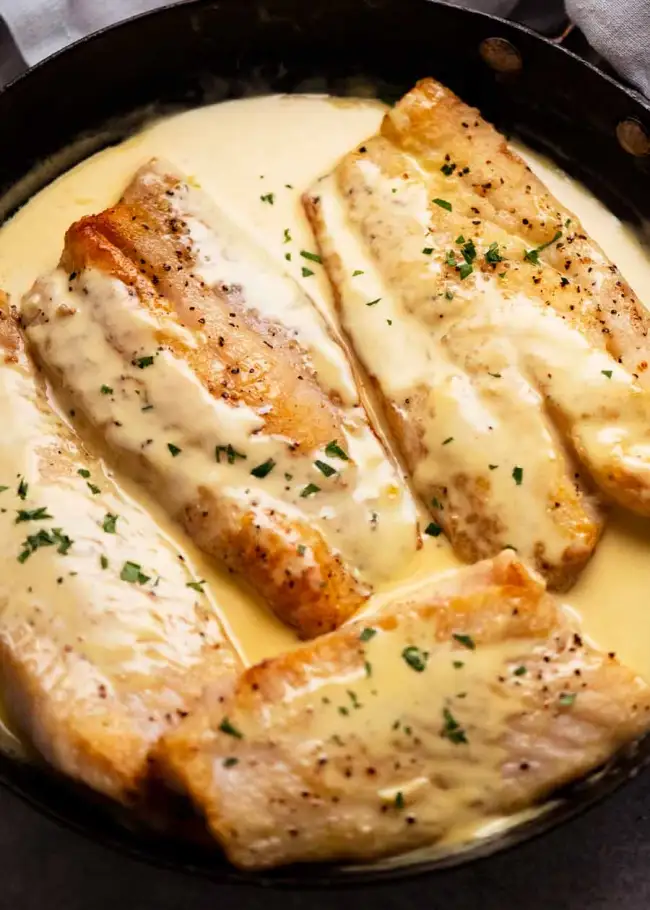
A Step-by-Step Guide to Baking Fish: A Delicious and Healthy Dish for Everyone
Introduce your taste buds to an experience like no other as we embark on a flavorful journey into the world of oven-baked fish. Imagine tender, flaky fillets infused with vibrant seasonings, a perfect balance of flavors, and a hint of citrusy zest.
Baking fish in the oven is more than a cooking method; it’s a culinary art that transforms the ordinary into the extraordinary.
In this cooking expedition, we’ll guide you through each step, demystifying the process of baking fish with simple, practical explanations. You’ll discover that crafting a mouthwatering, healthy meal is within your reach, even if you’re not a seasoned chef. (Read also: When is crawfish season?)
Prepare to tantalize your taste buds, impress your loved ones, and elevate your home cooking game as we delve into the art of baking fish in the oven. Your culinary journey starts here.
Recommended: How To Use Stockfish And Its Health Benefits
Why Bake Fish?
Baking fish is not only a healthier alternative to frying, but it also locks in the natural flavors and moisture of the fish. It’s a versatile method that works well with various types of fish, from salmon to tilapia, cod, and more. Plus, you can customize the seasonings and accompaniments to your liking.
Ingredients needed to bake fish in the oven
Here’s what you’ll need to bake fish (for 2 servings)
- 2 fish fillets (e.g., salmon, tilapia, cod) – approximately 6-8 ounces each
- 2 tablespoons of olive oil
- 1 teaspoon of lemon juice
- 1/2 teaspoon of salt
- 1/4 teaspoon of black pepper
- 1/4 teaspoon of paprika
- 1/4 teaspoon of garlic powder
- 1/4 teaspoon of dried thyme (optional)
- 1/4 teaspoon of dried dill (optional)
- 1 lemon, sliced (for garnish)
- Fresh herbs (e.g., parsley or dill) for garnish
Read also: Are sardine fish good for you
Equipment
- Baking dish or oven-safe skillet
- Aluminum foil or parchment paper (for easy cleanup)
- Cooking spray or a bit of oil (for greasing the dish)
Now that you’ve gathered your ingredients and equipment, let’s dive into the step-by-step process

How To Bake Fish In The Oven
Preheat Your Oven
- Start by preheating your oven to 375°F (190°C). It’s important to ensure that your oven is fully heated before placing your fish inside for even cooking.
Prepare the Baking Dish
- To make cleanup a breeze, line your baking dish with aluminum foil or parchment paper. This step is optional but highly recommended. Grease the lined dish with cooking spray or a bit of oil to prevent the fish from sticking.
Read also: How To Make Peppered Fish In Less Time
Season the Fish
- Place the fish fillets in the prepared baking dish. Drizzle 2 tablespoons of olive oil evenly over the fillets. This not only adds flavor but also helps keep the fish moist during baking. Sprinkle 1 teaspoon of lemon juice over the fish to give it a delightful zing.
- In a small bowl, combine 1/2 teaspoon of salt, 1/4 teaspoon of black pepper, 1/4 teaspoon of paprika, 1/4 teaspoon of garlic powder, and 1/4 teaspoon of dried thyme (if using).
- Mix these seasonings well, and then sprinkle the mixture evenly over the fish fillets. Don’t forget to season both sides of the fillets for all-around flavor.
Customize with Herbs
- If you’d like to enhance the flavor of your baked fish even more, consider adding some dried herbs like thyme or dill. These herbs pair beautifully with fish. Simply sprinkle 1/4 teaspoon of dried thyme and 1/4 teaspoon of dried dill over the fillets, or choose your favorite herbs to customize the flavor.
Garnish with Lemon Slices
- To infuse your fish with a fresh, citrusy aroma, place slices of lemon on top of the fillets. Lemon pairs wonderfully with most fish types and adds a bright, zesty kick.

Bake Your Fish
- With your seasoned fish fillets in the prepared baking dish, it’s time to bake them. Place the dish in the preheated oven and let the fish cook for about 12-15 minutes, depending on the thickness of the fillets. Generally, you should bake fish for 10 minutes per inch of thickness.
- To check for doneness, use a fork to gently flake the fish. It should easily separate into moist, opaque flakes when it’s ready. Keep in mind that slightly undercooking the fish is better than overcooking it. You can always return it to the oven for a few more minutes if needed.
Garnish and Serve
- Once your fish is cooked to perfection, remove it from the oven. Garnish with fresh herbs like parsley or dill for a burst of color and a hint of freshness.

Side Dish Options
Baked fish pairs wonderfully with various side dishes. Here are a few ideas to consider.
- Steamed Vegetables: Steamed broccoli, asparagus, or green beans make great companions for baked fish. They’re quick to prepare and offer a nutritional balance to your meal.
- Rice or Quinoa: A side of fluffy rice or quinoa can complete your meal. The grains soak up the flavorful juices from the fish and add a hearty touch to your plate.
- Salad: A fresh green salad with a light vinaigrette is a great choice for a refreshing side dish.
- Roasted Potatoes: If you’re craving something heartier, consider pairing your fish with roasted potatoes or sweet potatoes. Toss them in olive oil, season with salt and pepper, and roast them alongside your fish for a complete one-pan meal.
Check Out this
11 Classic Pans For Cooking fish With Images
6 Foods that Fight Brain Fog: Boost Your Mental Clarity
Top 23 Tasty And Healthy Filipino Recipes For Guilt-Free Meals
How To Make Peppered Fish In Less Time
Tips for Success
- Selecting Fish: Choose fresh fish fillets that are firm, moist, and have a mild, ocean-like aroma. Frozen fillets are a convenient option but be sure to thaw them in the refrigerator before baking.
- Avoid Overcooking: As mentioned earlier, slightly undercooking the fish is better than overcooking it. Fish continues to cook for a short period after being removed from the oven, so keeping an eye on it is essential.
- Enhancing Flavor: Don’t hesitate to customize your baked fish with seasonings you love. You can experiment with different herbs, spices, or even a drizzle of balsamic glaze for a unique flavor profile.
- Checking Doneness: The easiest way to check if your fish is done is to use a fork. When the fish flakes easily and is opaque all the way through, it’s ready.
- Storage: If you have leftovers, store them in an airtight container in the refrigerator. Fish is best when consumed within a day or two.
I typically opt for white fish like cod, tilapia, or halibut, although salmon works wonderfully too. It’s best to use relatively thick fillets to ensure they stay moist during baking.
I personally prefer skinless fillets because this method won’t crisp up the skin, but you can certainly use fish with the skin intact.
While fresh fillets offer a superior texture, frozen ones can still be used effectively. Just make sure to thoroughly defrost them and pat them dry to eliminate excess moisture, which could result in sogginess when seasoned and baked.
Bake fish at 375°F (190°C) for about 12-15 minutes per inch of thickness. Use a fork to gently flake the fish; it’s done when it easily separates into moist, opaque flakes.
To bake fish at 350°F (175°C), you’ll need approximately 15-20 minutes per inch of thickness. Remember to check for doneness by using a fork to flake the fish; it’s ready when it easily separates into moist, opaque flakes.
To bake fish at 400°F (200°C), you’ll typically need about 10-12 minutes per inch of thickness. As always, check for doneness by using a fork to flake the fish; it’s ready when it easily separates into moist, opaque flakes.
Conclusion
Baking fish may seem like a daunting task, but as you’ve seen, it’s a straightforward and rewarding cooking technique.
With the right ingredients, a few essential steps, and attention to detail, you can create a restaurant-quality baked fish dish right in your own kitchen.
Whether you’re aiming for a healthy, weeknight meal or a special dinner for guests, baked fish is a versatile and impressive option.
So, next time you’re in the mood for a delicious, nutritious dish, try your hand at baking fish, and savor the delightful results. Happy cooking!
